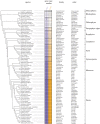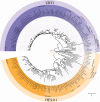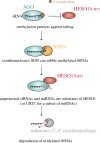RNA uridylation and decay in plants
- PMID: 30397100
- PMCID: PMC6232585
- DOI: 10.1098/rstb.2018.0163
RNA uridylation and decay in plants
Abstract
RNA uridylation consists of the untemplated addition of uridines at the 3' extremity of an RNA molecule. RNA uridylation is catalysed by terminal uridylyltransferases (TUTases), which form a subgroup of the terminal nucleotidyltransferase family, to which poly(A) polymerases also belong. The key role of RNA uridylation is to regulate RNA degradation in a variety of eukaryotes, including fission yeast, plants and animals. In plants, RNA uridylation has been mostly studied in two model species, the green algae Chlamydomonas reinhardtii and the flowering plant Arabidopsis thaliana Plant TUTases target a variety of RNA substrates, differing in size and function. These RNA substrates include microRNAs (miRNAs), small interfering silencing RNAs (siRNAs), ribosomal RNAs (rRNAs), messenger RNAs (mRNAs) and mRNA fragments generated during post-transcriptional gene silencing. Viral RNAs can also get uridylated during plant infection. We describe here the evolutionary history of plant TUTases and we summarize the diverse molecular functions of uridylation during RNA degradation processes in plants. We also outline key points of future research.This article is part of the theme issue '5' and 3' modifications controlling RNA degradation'.
Keywords: RNA decay; RNA degradation; mRNAs; terminal nucleotidyltransferase; uridylation.
© 2018 The Author(s).
Conflict of interest statement
We declare we have no competing interests.
Figures








Similar articles
-
Uridylation Earmarks mRNAs for Degradation… and More.Trends Genet. 2016 Oct;32(10):607-619. doi: 10.1016/j.tig.2016.08.003. Epub 2016 Sep 1. Trends Genet. 2016. PMID: 27592415 Review.
-
Uridylation of mature miRNAs and siRNAs by the MUT68 nucleotidyltransferase promotes their degradation in Chlamydomonas.Proc Natl Acad Sci U S A. 2010 Feb 23;107(8):3906-11. doi: 10.1073/pnas.0912632107. Epub 2010 Feb 8. Proc Natl Acad Sci U S A. 2010. PMID: 20142471 Free PMC article.
-
An extensive survey of phytoviral RNA 3' uridylation identifies extreme variations and virus-specific patterns.Plant Physiol. 2023 Aug 31;193(1):271-290. doi: 10.1093/plphys/kiad278. Plant Physiol. 2023. PMID: 37177985 Free PMC article.
-
Turnover of Mature miRNAs and siRNAs in Plants and Algae.Adv Exp Med Biol. 2011;700:124-39. doi: 10.1007/978-1-4419-7823-3_11. Adv Exp Med Biol. 2011. PMID: 21755478
-
Turnover of mature miRNAs and siRNAs in plants and algae.Adv Exp Med Biol. 2010;700:124-39. Adv Exp Med Biol. 2010. PMID: 21627035 Review.
Cited by
-
The Chloroplast Epitranscriptome: Factors, Sites, Regulation, and Detection Methods.Genes (Basel). 2021 Jul 24;12(8):1121. doi: 10.3390/genes12081121. Genes (Basel). 2021. PMID: 34440296 Free PMC article. Review.
-
5' and 3' modifications controlling RNA degradation: from safeguards to executioners.Philos Trans R Soc Lond B Biol Sci. 2018 Nov 5;373(1762):20180160. doi: 10.1098/rstb.2018.0160. Philos Trans R Soc Lond B Biol Sci. 2018. PMID: 30397097 Free PMC article.
-
The role of 3' end uridylation in RNA metabolism and cellular physiology.Philos Trans R Soc Lond B Biol Sci. 2018 Nov 5;373(1762):20180171. doi: 10.1098/rstb.2018.0171. Philos Trans R Soc Lond B Biol Sci. 2018. PMID: 30397107 Free PMC article. Review.
-
Terminal nucleotidyl transferases (TENTs) in mammalian RNA metabolism.Philos Trans R Soc Lond B Biol Sci. 2018 Nov 5;373(1762):20180162. doi: 10.1098/rstb.2018.0162. Philos Trans R Soc Lond B Biol Sci. 2018. PMID: 30397099 Free PMC article. Review.
-
The TUTase URT1 connects decapping activators and prevents the accumulation of excessively deadenylated mRNAs to avoid siRNA biogenesis.Nat Commun. 2021 Feb 26;12(1):1298. doi: 10.1038/s41467-021-21382-2. Nat Commun. 2021. PMID: 33637717 Free PMC article.
References
Publication types
MeSH terms
Substances
Associated data
LinkOut - more resources
Full Text Sources

